‘The White Lotus’: Making Episode 5’s Unsettling Climax

- Oops!Something went wrong.Please try again later.
- Oops!Something went wrong.Please try again later.
The first five episodes of this season of “The White Lotus” have involved a high number of bad decisions in beautiful locations and the series’ signature angst over wealth and privilege. But it’s not until the end of Episode 5, “That’s Amore,” that the show reveals an appropriately operatic twist — spoilers ahead — with Tanya’s (Jennifer Coolidge) discovery of expat Quentin (Tom Hollander) in flagrante delicto with his nephew Jack (Leo Woodall) in the elder’s Palermo palazzo.
To be fair, Jack was introduced to Tanya and her assistant, Portia (Haley Lu Richardson), as naughty, but this new devilry is very much in the details. So is the show’s artistry, and it took a team effort on the part of the show’s camera, sound, and music to accentuate the horror of what Tanya finds and cinematically set the stage for the final two episodes of the season, where things will really go off the rails.
More from IndieWire
The sequence begins ominously enough on open flames, the shadowed pathways of the palazzo exterior, and close-ups of weathered statues and carved gargoylesque reliefs. Unsettling chimes and animal noises in the score mingle with the sound of breathing flame, because of course Tom Hollander’s pleasure palace has braziers at regular intervals. “We actually work a lot with the music,” supervising sound editor Kathryn Madsen told IndieWire. “Sometimes we’ll even put like a low rumble under cues. They do some sound design-y elements in the music as well, and we work with that. There’s a lot of interplay between the music and the sound on the show.”

Screenshot/HBO
The interplay here gives all of the stone faces a sense of animalistic power. Like the chattering monkeys of Season 1, “White Lotus” Season 2 finds whatever ways it can through its locations to convey the sense that there are primal spirits watching the follies of man. These qualities of the villa actually contributed to where the show shot the sequence. “The two palazzos [in Season 2] were actually on the opposite sides of Sicily,” cinematographer Xavier Grobet told IndieWire. “The one that we used for Palermo was in Noto and the one that we used for Noto was in Palermo. We changed it because the one palazzo was better for the more intriguing scenes and the other was more like opulent place you’d want to stay in,” Grobet said.
“The location itself gives you the emotion of the scene. That’s how you get it. Once you have that location, then everything else follows from that: the way you light it, the way you move the camera, the way you stage the scene to create moments of tension.” Grobet creates that immediate sense of something off and wrong in the dark with the shots of the villa architecture, and the show even gets a little cheeky by putting an apple on Tanya’s nightstand she briefly considers when a sound wakes her up in the middle of the night. But once she’s on the move, Grobet employs a deeply unsettling dolly zoom of the opulent interior.
“It’s written into the pages – not the style, but the feeling of [the scene]. So it almost asks you to go that way, you know?” Grobet said. “It’s a very voyeuristic thing to do because you are actually picking into their lives and you’re trying to see even farther than you’re allowed to see. So [the show’s visual style] accentuates that feeling of surveillance and intrusion into their lives. I like to make the camera feel as if we were a character as well.” Grobet emphasizes that first-person perspective very explicitly here, as normal tracking shots of Tanya walking through the corridors are intercut with more dolly zooms, in parts of the palace that Tanya may or may not pass by. Those shots are for our perspective, and for us to start freaking out.

Screenshot/HBO
A sense of the weird and the wrong guides the development of the score, too. “We went for something a little more dramatic, maybe, because it’s anticipating how things might be going towards the end of the show,” composer Cristobal Tapia de Veer told IndieWire. “It’s always towards the end of an episode that things become a little bit more serious. All of a sudden we’re left in the credits with some kind of mysterious vibe of what might happen.” The goal with these moments for Tapia de Veer and co-composer Kim Neundorf was to create cues that felt very dark but also sensual, unfolding slowly but getting ever more operatic.
The slow build was also important for Madsen and the sound team. “When Tanya (Jennifer Coolidge) is laying in bed and she hears this sound and it almost sounds like someone could be having a nightmare or someone’s in pain or something,” Madsen said. It was important to withhold the mystery of what the sounds really are until the last possible moment and until Grobet’s quite voyeuristic shot of Tanya peering around a mirror, so both her eyes and the glass catch the image of Jack and Quentin having sex.
But Madsen was helped by the way sound works on “The White Lotus” overall. “[Creator Mike White] does these transitions between the scenes and it’s shots of waves or it’s shots of rock, scenic shots. But if you pay attention, the sound will kind of give hints into the emotional state of a character. It could be beautiful, it could be dreamy, or it could be a little bit menacing and like there’s a storm brewing underneath, and we do that with the sound,” Madsen said. “We are carefully crafting the backgrounds in this show to build the tension. There are two key scenes coming up in Episode 6 and 7 where we purposefully have the background start kind of normal and amp [the noise] up. You won’t notice it unless you’re watching for it, but you’ll feel it.”

Screenshot/HBO
Once we and Tanya can’t unsee what we’ve seen, the show itself seems startled for a moment. It cuts away from the space to a painting of a naked woman crying – a woman seemingly as angry as Harper (Aubrey Plaza) is now that she thinks she knows Cam (Theo James) led her husband Ethan (Will Sharpe) to cheat on her. Then the camera lets Tanya leave but still lingers just on the edge of the room, on a candle-lit altar that is both beautiful and horrible. “All kinds of [detail shots] addressed the opulence and the elegance of the location and the guests, which is the language of the show,” Grobet said. “The camera translates the tension that is built up in the scripts with the characters.”
And that is perhaps the most chilling and exciting thing about Episode 5’s cliffhanger ending: When the camera loses its cool, as it does here, the characters are sure to follow.
Best of IndieWire
The Best True Crime Streaming Now, from 'Unsolved Mysteries' to 'McMillions' to 'The Staircase'
'The Last of Us' Sets Early 2023 Release at HBO: Here's Everything You Need to Know
Sign up for Indiewire's Newsletter. For the latest news, follow us on Facebook, Twitter, and Instagram.

